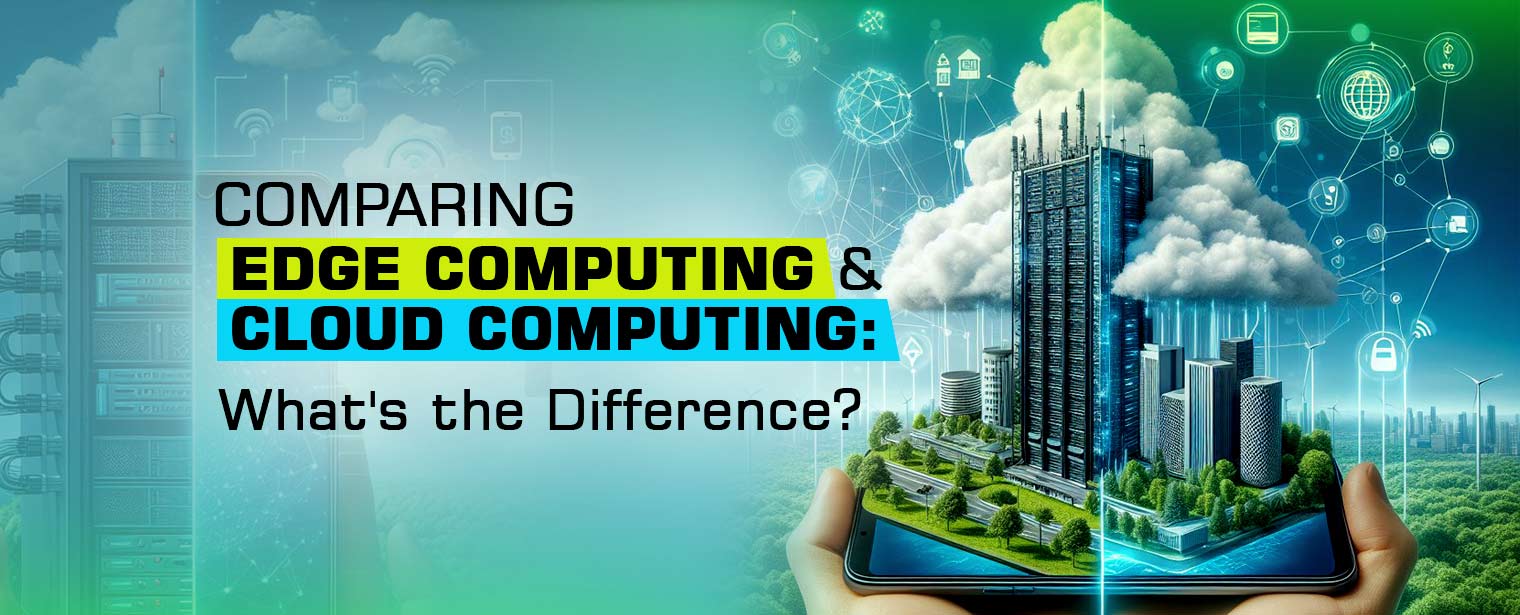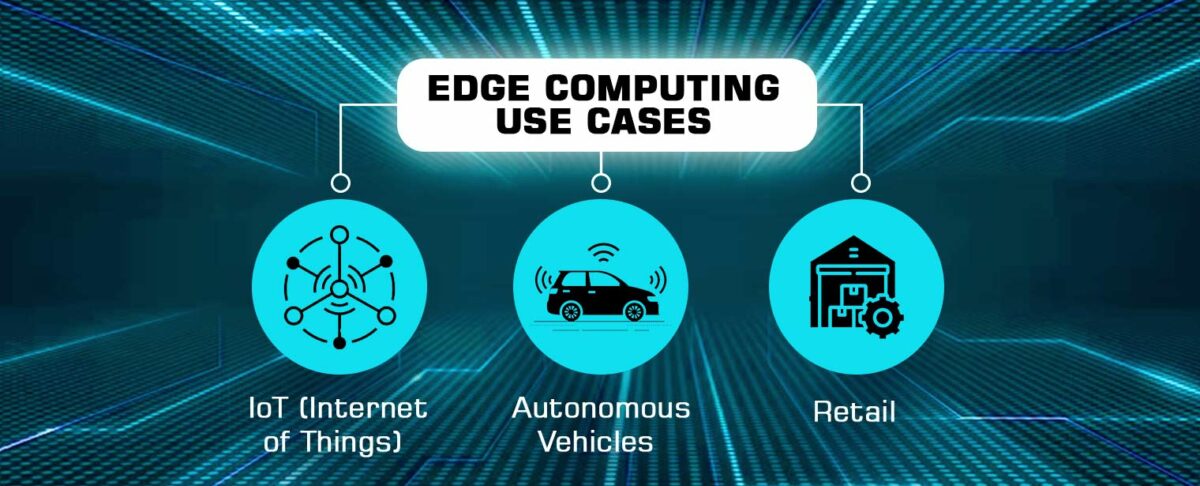Comparing Edge Computing and Cloud Computing: What’s the Difference?

Introduction
In the ever-evolving landscape of technology, the terms “edge computing” and “cloud computing” have become ubiquitous. These two paradigms represent distinct approaches to handling data, processing, and storage. As businesses and individuals continue to rely on digital infrastructure, understanding the differences between edge and cloud computing becomes crucial. In this blog, we will delve into the intricacies of both technologies, exploring their unique characteristics, applications, and how they coexist in the broader realm of computing.
Defining Edge Computing and Cloud Computing
Before delving into the comparison, let’s establish a foundational understanding of edge computing and cloud computing.
Edge Computing: Bringing Computation Closer

In the ever-evolving realm of technology, edge computing emerges as a transformative force, reshaping the way we process and analyze data. Unlike traditional cloud computing, which centralizes data processing in remote servers, edge computing brings computation closer to the data source. This decentralization minimizes latency and enhances real-time processing, making it a game-changer across industries.
Edge computing’s impact is most notable in the realms of IoT (Internet of Things) and AI (Artificial Intelligence). By processing data locally on devices or edge servers, edge computing reduces the strain on network bandwidth and ensures faster response times. This proves crucial in applications ranging from autonomous vehicles and smart cities to healthcare and manufacturing.
Furthermore, edge computing enhances data privacy and security by reducing the need to transmit sensitive information to centralized cloud servers. This distributed approach mitigates risks and ensures a more resilient and reliable system.
As we navigate the era of digital transformation, edge computing stands at the forefront, revolutionizing how we harness the potential of data. Its ability to provide real-time insights, improve efficiency, and foster innovation positions edge computing as a cornerstone in the architecture of the future. Embracing this technology opens doors to a new era of possibilities, where speed, efficiency, and security converge to shape a more connected and intelligent world.
Cloud Computing: The Power of Centralized Resources

In the rapidly evolving landscape of technology, cloud computing stands tall as a transformative force, reshaping the way we store, access, and process data. Cloud computing enables businesses and individuals to transcend the limitations of traditional computing, offering unparalleled flexibility, scalability, and accessibility.
At its core, cloud computing involves the delivery of computing services—such as storage, processing power, and applications—over the internet. This eliminates the need for local infrastructure, empowering users to tap into a vast network of remote servers. This not only reduces the burden of maintaining complex hardware but also enhances efficiency and cost-effectiveness.
One of the key advantages of cloud computing is scalability. Organizations can effortlessly scale their resources up or down based on demand, ensuring optimal performance and resource utilization. This elasticity proves crucial in handling fluctuating workloads and accommodating the ever-growing data volumes of the digital age.
Moreover, cloud computing fosters collaboration by providing real-time access to data and applications from any location. This flexibility promotes remote work and accelerates innovation, enabling businesses to adapt swiftly to changing market dynamics.
As we look to the future, the cloud’s horizon seems boundless. With ongoing advancements in security, artificial intelligence, and edge computing, cloud technology continues to redefine the possibilities of the digital realm, promising a future where the sky is no longer the limit.
Key Differences in Architecture
The fundamental difference between edge computing and cloud computing lies in their architecture.
1. Proximity to Data Source
– Edge Computing: Data processing occurs near the source of data generation, reducing the need to transmit large volumes of data to a centralized server. This proximity minimizes latency and enhances real-time processing capabilities.
– Cloud Computing: Data is processed in centralized data centers that may be located remotely from the source of data generation. While this enables scalability and resource pooling, it introduces latency, especially in applications requiring real-time responsiveness.
2. Latency and Speed
– Edge Computing: Low-latency processing is a primary advantage of edge computing. This is particularly critical in applications such as autonomous vehicles, where split-second decisions are crucial for safety.
– Cloud Computing: The centralized nature of cloud computing introduces latency, making it less suitable for applications that demand instantaneous responses. However, cloud services are well-suited for tasks that do not require real-time processing.
3. Bandwidth Usage
– Edge Computing: By processing data locally, edge computing reduces the need for transmitting large volumes of data over the network, leading to more efficient bandwidth utilization.
– Cloud Computing: Transmitting data to and from centralized data centers consumes bandwidth. While advancements in network infrastructure have mitigated some of these concerns, bandwidth usage remains a consideration for certain applications.
Use Cases and Applications
The choice between edge computing and cloud computing often depends on the specific requirements of an application. Here, we explore some common use cases for each paradigm.
Edge Computing Use Cases:

– IoT (Internet of Things): Edge computing is ideal for IoT applications, where numerous sensors and devices generate data that requires real-time processing. This includes smart cities, industrial IoT, and healthcare applications.
– Autonomous Vehicles: Edge computing enables rapid decision-making for autonomous vehicles by processing sensor data locally. This is critical for ensuring the safety and efficiency of these systems.
– Retail: In retail, edge computing can be employed for inventory management, personalized customer experiences, and security monitoring.
Cloud Computing Use Cases:

– Data Storage and Processing: Cloud computing is widely used for storing and processing large volumes of data. Businesses leverage cloud services for data analytics, machine learning, and business intelligence.
– Web Applications: Cloud services provide scalable infrastructure for hosting web applications. This allows businesses to adapt to changing demands without the need for significant upfront investments in hardware.
– Collaboration and Communication: Cloud-based communication and collaboration tools, such as email, document sharing, and video conferencing, have become essential in modern business environments.
The Hybrid Approach: Bringing Edge and Cloud Together
Recognizing the strengths and weaknesses of both edge and cloud computing, many organizations are adopting a hybrid approach. In a hybrid model, edge and cloud computing work synergistically to create a comprehensive and efficient computing infrastructure.
– Data Processing at the Edge: Edge computing handles real-time processing and critical decision-making, reducing latency and ensuring quick responses in applications such as IoT and autonomous vehicles.
– Scalability and Resource Availability in the Cloud: Cloud computing provides the scalability and resource availability needed for data storage, complex analytics, and non-real-time processing tasks.
– Secure Data Transmission: Edge devices can preprocess sensitive data locally before transmitting only relevant information to the cloud, addressing security and privacy concerns.
Challenges and Considerations
While edge and cloud computing offer distinct advantages, they also present unique challenges that organizations must address.
Edge Computing Challenges:
– Limited Resources: Edge devices often have limited computational and storage capabilities compared to cloud data centers.
– Security Concerns: Distributing computation raises security concerns, especially in uncontrolled environments. Ensuring the security of edge devices is a critical consideration.
– Management Complexity: Managing a distributed edge infrastructure can be more complex than centralized cloud management.
Cloud Computing Challenges:
– Latency: Cloud computing introduces latency due to the physical distance between the data source and the centralized data center.
– Bandwidth Requirements: Transmitting large volumes of data to and from the cloud requires substantial bandwidth, which may be a limitation in some scenarios.
– Dependency on Internet Connectivity: Cloud services are dependent on internet connectivity, and disruptions can impact accessibility.
Conclusion
In the dynamic landscape of computing, both edge computing and cloud computing play crucial roles, each offering unique advantages and addressing specific use cases. The choice between the two—or a combination of both—depends on factors such as application requirements, latency sensitivity, scalability needs, and security considerations.
As technology continues to advance, the integration of edge and cloud computing will likely become more seamless, providing organizations with the flexibility to design computing architectures that best suit their specific needs. In this ongoing evolution, staying informed about the strengths, challenges, and potential synergies of edge and cloud computing is essential for making informed decisions and harnessing the full potential of modern computing paradigms.

